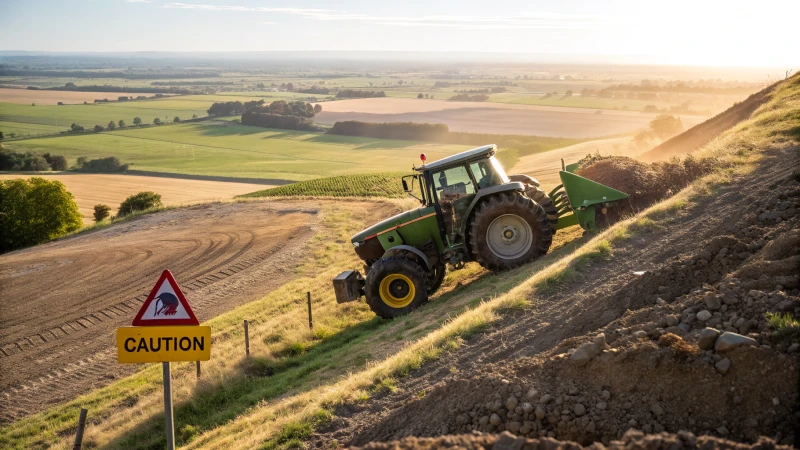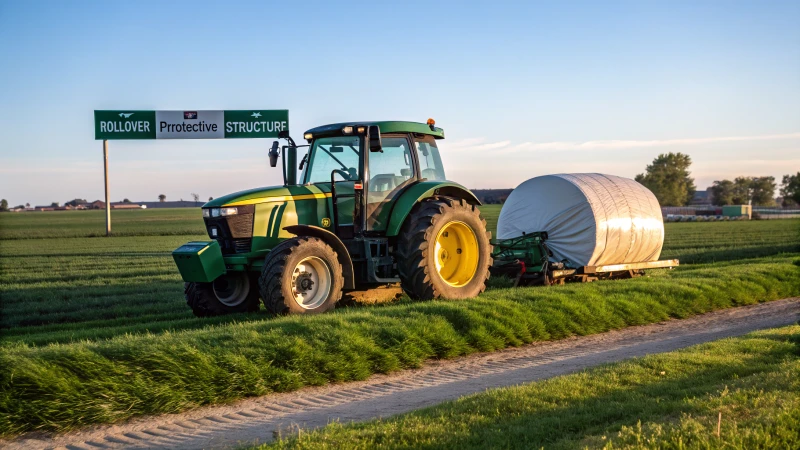
Ever wondered what makes tractors tip over and how we can keep them upright?
The leading causes of tractor rollovers include uneven terrain, operator errors, equipment malfunctions, and inadequate use of safety devices like Rollover Protective Structures (ROPS). Addressing these issues through proper training, equipment maintenance, and safety practices can significantly reduce rollover incidents.
Thinking back to the first time I saw a tractor tip over, it was a mix of fear and amazement. The driver was okay, thankfully, but it highlighted just how crucial understanding these risks really is. Uneven ground, like that tricky slope on my uncle's farm, can throw off even the most seasoned operator. Then there's human error—those moments when we're in a hurry or distracted. Add in mechanical faults, which I learned the hard way when a steering malfunction sent me skidding sideways once, and it's clear why rollovers happen.
But here's the silver lining: by diving into these causes, we can pick up practical tips to prevent such accidents. Let's explore how we can tackle each one, ensuring our work stays productive and safe.
Uneven terrain is a leading cause of tractor rollovers.True
Tractors often operate on rough fields, increasing rollover risk.
Rollover Protective Structures (ROPS) are ineffective in rollovers.False
ROPS significantly reduce injury risk by preventing full rollovers.
What Role Does Terrain Play in Tractor Rollovers?
Have you ever found yourself on a tractor, staring down a steep hill and feeling your heart race a little?
Tractor rollovers are greatly affected by terrain. Slopes, uneven, or loose grounds can destabilize tractors, increasing rollover risks. Operators must adjust their driving techniques and stay vigilant to ensure safety.

The Impact of Slopes and Inclines
I remember this one time, I was helping out on a friend’s farm, and we had this old tractor that seemed like it was ready for retirement. We were trying to navigate a hilly patch when the tractor started leaning awkwardly. My stomach did a little flip as I realized how the tractor's center of gravity1 was shifting. On slopes, the weight distribution gets tricky, and it’s easy for the machine to tip over if you’re not careful. So now, whenever I’m dealing with inclines, I make sure to drive straight up or down and avoid those tempting diagonal shortcuts.
Navigating Uneven Surfaces
There was another instance when we were clearing a field, and the ground was full of these hidden surprises—ditches and rocks just waiting to jolt you out of your seat. It made me realize how important it is to do a thorough field inspection before hopping on the tractor. Using ground leveling tools2 has become a part of my routine now because it’s better to be safe than sorry.
The Challenge of Loose and Wet Grounds
And oh, the joy of getting stuck in mud! Once, after a good rain, I found myself in a literal sticky situation. The wheels spun, and the traction was gone—talk about a slippery slope! Since then, I’ve learned that wider tires and adding weight can make a world of difference in these conditions. And those sudden turns or stops? I avoid them like the plague.
Tips for Safe Tractor Operation
Here's a quick guide to safe tractor practices:
| Terrain Type | Safety Measure |
|---|---|
| Slopes | Drive straight on slopes |
| Uneven surfaces | Inspect fields for hidden obstacles |
| Loose/Wet grounds | Use wider tires for better traction |
By keeping these measures in mind, we can manage terrain-related risks more effectively.
Evaluating Terrain Before Operation
Before starting any work, I make it a point to assess the terrain. Identifying potential hazards like steep inclines or wet patches helps me plan my route better. Tools like satellite maps3 have become indispensable in my planning process. By truly understanding the terrain, we can significantly lower the chances of an accident.
Tractors are safer on flat terrain than on slopes.True
Flat terrain offers stable weight distribution, reducing rollover risk.
Driving diagonally on slopes is the safest method.False
Driving straight up or down slopes minimizes rollover risk.
What Common Operator Errors Lead to Rollovers?
Tractor rollovers can turn a day on the farm into a dangerous ordeal. Knowing the common missteps operators make can help keep your wheels safely on the ground.
Rollover accidents often stem from operator errors like speeding, sharp turns, and uneven braking. These actions can tip tractors, especially on slopes or rough terrain, highlighting the need for careful handling.

Excessive Speed and Sharp Turns
I've learned the hard way that tractors aren't just big, powerful machines—they're also delicate when it comes to balance. Years ago, I thought I could handle taking a sharp turn a bit too fast. Before I knew it, the tractor was tipping, and I had to act quickly to avoid disaster. It's crucial to remember that high speeds shift the tractor's center of gravity, making it more prone to rolling over.
| Factor | Impact on Stability |
|---|---|
| Speeding | Increases momentum, shifting center of gravity |
| Sharp Turns | Heightens risk of tipping due to centrifugal force |
Uneven Braking
Uneven braking is another tricky issue. Imagine you're heading downhill with a full load, and suddenly you brake harder on one side than the other. It happened to me once while hauling hay on a slope. The tractor began to skid, and my heart skipped a beat as I scrambled to regain control. Consistent, even braking is essential to maintain stability.
Improper Hitching and Loading
Another lesson from my early farming days: hitching equipment without following proper guidelines is a surefire way to get into trouble. I once hitched a plow too low, causing an awkward angle and leading to a bumpy ride that almost ended in a rollover. Always check your equipment and follow the manufacturer's guidelines4 closely.
Raised Front-End Loader
I've seen how a raised front-end loader can make a tractor feel like it's walking on stilts. Keeping it low while moving is best practice because it helps maintain a lower center of gravity.
Terrain Challenges
Every farmer knows that fields can hide many surprises—rocks, ditches, you name it. Once, I drove over what seemed like flat ground only to hit a hidden ditch that nearly tipped the tractor. Scanning for obstacles is key to safe navigation.
For more tips on managing tricky terrain, check out terrain handling tips5.
Driving too fast increases rollover risk in tractors.True
High speeds shift the center of gravity, increasing toppling risk.
Uneven braking is safe when traveling downhill.False
Uneven braking causes skidding, leading to instability and rollovers.
How Can You Prevent Tractor Rollovers?
You know, it's easy to forget how powerful and unpredictable tractors can be until you experience or witness a near-miss. Ensuring safety on the field isn't just about following rules; it's about coming home safe every day.
Preventing tractor rollovers requires installing Rollover Protective Structures (ROPS), maintaining optimal tire pressure, ensuring proper weight distribution, and adhering to safe operation guidelines. Regular training and diligent equipment upkeep are also crucial for safety.

Understanding Rollover Protective Structures (ROPS)
I remember the first time I really understood the danger of tractor rollovers. It was during my early days working on the farm, and I saw an experienced operator misjudge a slope. Thankfully, he had Rollover Protective Structures (ROPS)6 installed, which kept him safe. That incident taught me how essential these structures are. ROPS create a safety zone around the driver, drastically reducing injury risk in a rollover event. Of course, they're most effective when used with seatbelts, a lesson that sticks with you after such a close call.
| Feature | Description |
|---|---|
| ROPS Types | Fixed frame, foldable, and telescopic |
| Benefits | Provides a safety zone, reduces fatality risks |
| Installation | Must be installed by professionals |
Importance of Regular Equipment Maintenance
But safety doesn't stop at ROPS. Maintaining your equipment is equally critical. I can't stress enough the importance of regular checks on brakes and steering systems to prevent unexpected failures. You'd be amazed how something as simple as tire inflation can make all the difference—an underinflated tire can shift weight balance, leading to a potential rollover.
- Brakes & Steering: Inspect regularly to ensure they're in tip-top shape.
- Tire Inflation: Keep them at the recommended pressure for stability.
- Weight Distribution: Properly load to maintain balance.
Tractor maintenance plays a vital role in preventing rollovers. Ensuring that all mechanical systems are functioning properly can prevent equipment-related accidents7.
Operator Training and Safe Practices
Training is another cornerstone of preventing rollovers. Once, during a training session, I learned about recognizing hazardous terrains and managing driving speeds—skills that have since become second nature. Knowing how to handle attachments and recognizing risky terrains are part of the comprehensive safety protocols every operator should master.
Implementing robust training programs can significantly cut down on accidents by teaching operators to:
- Identify hazardous terrains
- Drive at safe speeds
- Use attachments properly
Comprehensive training programs are essential to equip operators with these skills needed to prevent rollovers through operator training8.
Terrain Awareness and Environmental Factors
Finally, being aware of terrain and environmental conditions is critical. Operating on slopes or through loose soil can be treacherous if not managed carefully. I once found myself navigating a muddy path that nearly cost me control—it's moments like these that remind you to proceed with caution.
Operators should be mindful of:
- Slopes and Inclines: Avoid sideways operation on steep slopes.
- Loose Soil or Mud: Slow down to maintain control.
- Obstructions: Be vigilant of hidden hazards that could destabilize the tractor.
By understanding these environmental factors, operators can take preventative actions against rollovers.
ROPS significantly reduce rollover fatalities.True
ROPS create a protective zone, reducing fatality risks during rollovers.
Improper tire inflation does not affect tractor stability.False
Correct tire pressure is crucial for maintaining tractor stability.
Conclusion
Tractor rollovers are primarily caused by uneven terrain, operator errors, and equipment failures. Proper training, maintenance, and safety measures like ROPS can significantly reduce these incidents.
-
Learn how center of gravity impacts tractor stability and rollover risk. ↩
-
Discover tools that help level agricultural grounds for safer tractor operation. ↩
-
Explore satellite maps that aid in assessing field conditions before tractor operation. ↩
-
This link provides detailed instructions on proper hitching techniques to ensure balanced loading and enhance safety. ↩
-
Explore strategies for safely navigating challenging terrains, preventing rollovers by understanding field hazards. ↩
-
Learn about ROPS types and installation to enhance tractor safety. ↩
-
Explore why regular maintenance is crucial for preventing equipment failures. ↩
-
Discover training programs that improve operator skills and safety. ↩


